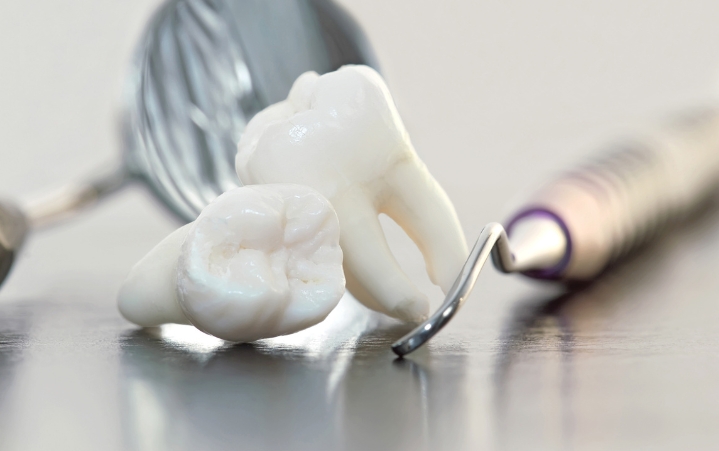Extractions
Simple/Surgical/ImpactedTooth Extraction Procedures
Tooth extraction is the removal of a tooth from its socket in the jawbone. Although it is a common procedure, tooth extraction is only done when necessary. Our experienced dentist can decide whether a procedure requires a simple or surgical extraction based on several factors, such as the age and the condition of surrounding tissue.
Tooth removal involves pulling a tooth from the socket. It usually done under local anaesthesia. Some people can handle tooth extractions without any issues, while others may experience complications, such as swelling in their face or pain in their jaw joint area.
Simple Extraction
A simple extraction is a non-surgical procedure on visible teeth above the gums, requiring minimal preparation. Furthermore, it does not involve cutting the gums. A dentist will use a forceps appliance to grasp the tooth at its crown, then twist it out of place using a quick movement.
The procedure is simple and quick, with no stitches or incisions required. The dentist numbs the area of the tooth to be extracted with a local anaesthetic and then removes it.
What is a Dental Hygiene Treatment?
Dental hygiene treatment, also known as dental cleaning or prophylaxis, is a preventive dental procedure performed by dental hygienists to maintain good oral health. The treatment involves the removal of dental plaque and tartar (calculus) that may have accumulated on the teeth, especially in areas that are difficult to reach through regular brushing and flossing. Here is what typically happens during a dental hygiene treatment:
- Assessment: The dental hygienist starts by assessing your overall oral health. They may ask about your medical history, examine your teeth and gums, and sometimes take X-rays to identify any underlying issues.
- Plaque and Tartar Removal: Using specialized dental instruments, the hygienist removes plaque and tartar from the surfaces of your teeth. Plaque is a soft, sticky film containing bacteria that forms on teeth, and if not removed, it can harden into tartar, which can lead to gum disease and cavities.
- Scaling: The hygienist may perform scaling, a process of removing tartar both above and below the gumline. This is important for preventing gum disease.
- Polishing: After scaling, the hygienist polishes your teeth using a gritty toothpaste-like material and a high-powered electric brush. Polishing helps remove surface stains and makes your teeth smoother, which makes it harder for plaque to accumulate.
- Flossing: The hygienist may floss your teeth to ensure that the spaces between your teeth are clean and free of plaque and food particles.
- Fluoride Treatment: In some cases, a fluoride treatment may be applied to your teeth. Fluoride helps strengthen tooth enamel and can prevent tooth decay.
- Education and Tips: Dental hygienists often provide valuable information about proper oral hygiene techniques, including brushing and flossing methods tailored to your specific needs. They may also discuss diet and lifestyle choices that affect your oral health.
Regular dental hygiene treatments are essential for maintaining good oral health and preventing dental problems. It is generally recommended to have a dental cleaning every six months, although your dentist or hygienist may suggest a different schedule based on your individual needs and oral health status.

Simple Extraction
A simple extraction is a non-surgical procedure on visible teeth above the gums, requiring minimal preparation. Furthermore, it does not involve cutting the gums. A dentist will use a forceps appliance to grasp the tooth at its crown, then twist it out of place using a quick movement.
The procedure is simple and quick, with no stitches or incisions required. The dentist numbs the area of the tooth to be extracted with a local anaesthetic and then removes it.
Surgical Extraction
A surgical extraction involves more preparation, and it is done on teeth that lie beneath the gums or are impacted. It can also be done when broken or damaged roots prevent normal removal with forceps alone. To remove these teeth, your dentist will make an incision in your gum tissue around the area where they are located, then cut through bone until they reach their target spot within your mouth. Once there is enough space to work on them further and remove them from behind their root structure, he will grab hold of each one individually before pulling it out with pliers or another specialized tool.

Surgical Extraction
A surgical extraction involves more preparation, and it is done on teeth that lie beneath the gums or are impacted. It can also be done when broken or damaged roots prevent normal removal with forceps alone. To remove these teeth, your dentist will make an incision in your gum tissue around the area where they are located, then cut through bone until they reach their target spot within your mouth. Once there is enough space to work on them further and remove them from behind their root structure, he will grab hold of each one individually before pulling it out with pliers or another specialized tool.
When Does a Tooth Qualify as A Surgical Extraction?
In most cases, simple tooth extraction is all that is needed. But there is some time when our dentist may perform a surgical extraction. A tooth qualifies as a surgical extraction if it meets one or more of these criteria:
- The tooth is severely decayed or broken.
- The tooth is impacted (not in the correct position within your jaw) and requires specialized tools to remove it safely.
- The large size of the tooth makes it difficult to access with dental instruments; this may be due to its location in your mouth or simply because it is unusually large for its species (for instance, impacted wisdom teeth are often removed surgically).
- You have an overbite issue that causes your lower jawbone to grow vertically instead of horizontally; this can cause some upper teeth to become narrow roots that can’t be accessed with standard dental instruments.
